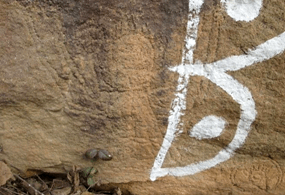Rock Art Sites Around The Delta Head On The Lower Mahanadi Valley, Odisha
Daitari Sahoo
| Abstract | The Rock Shelters with Rock Art |
| Introduction | Threats to rock shelter and rock art |
| Conclusion |
Abstract
The present paper is based on author’s recurrent archaeological explorations to locate prehistoric sites in the lower Mahanadi valley of Cuttack district in Odisha. Located in the eastern part of Odisha; the district Cuttack covers a major portion of the Mahanadi delta. The surface survey in the area has discovered numerous prehistoric sites significantly associated with various lithic artefacts belonging to the lower Palaeolithic, Mesolithic, and Neolithic periods from different localities around the delta head of the Mahanadi which comes under Athagarh, Banki and Cuttack Sadar subdivisions of Cuttack district. In addition to this, the survey has also documented, in total, five rock shelter sites from five distinct places mostly located on the forest clad sandstone hills of the Athgarh Gondwana Basin around the delta head in the study area. Irrespective of the presence or absence of rock art, the rock shelters sites recorded from the study area may be categorized into two types as (i) rock shelters without rock art and (ii) rock shelters with rock art evidences. Out of the five rock shelters there are only two rock shelters, which reveal the evidence of rock art in the form of typical petroglyphs. The discovered rock art sites are located at two different places: one at the foothills of the Siddheswar Mundia nearby the village Naraj on the south of the Mahanadi, and another at a natural cave on the waist of the Haripuli hills in the Subasi Reserve Forest area on the north of the Mahanadi. Both the rock art sites have faced same fate due to anthropogenic impacts on the ravages of time. Thus in this paper, author describes geoarchaeolgy of the rock art sites, interprets the rock art, and discusses the threats to them, and their salvage.
Keywords: Prehistoric, sites, rock shelter, rock-art, delta-head, gondwana, petroglyphs, anthropogenic, environmental
1. Introduction
Rock art sites with pictographs (paintings) and petroglyphs (engravings) have been documented from all parts of the world, except Antarctica. Asia, being the largest continent has diverse rock art heritage in global context. Rock art is found in deep caves as well as on high mountains from the tropics to the arctic regions (Chakravarty and Bednarik, 1997:2). As far as the historiography of rock art research reveals, India has a long history of rock art research as it began very early since 1856. While the petroglyphs were first reported from Almora in the subcontinent by W.G. Henwood as early as 1856, the pictographs were first recorded in 1867- 68 by Archibald Carlleyle at Sohagi Ghat in the sandstone hills of Vindhyas, Mirzapur district presently in Uttar Pradesh (Chakravarty and Bednarik, 1997:29; Chakraverty, 2003). Subsequently, numerous discoveries were documented on the rock art in India during the late nineteenth century by John Cockburn in 1883; F. Fawcett in 1892 and in early twentieth century by M. Ghosh in 1932. The discovery of a large complex of painted rock shelters at Bhimbetka by V.S. Wakankar in 1950s highly influenced a number of scholars to carry out exploration and documentation with much focus on the central region. However, various rock art in the form of pictographs (usually pigmented pictures or paintings in the rock surface by hands or crude brushes) and petroglyphs (usually images or motifs executed on rocks by engraving, carving and bruising through any though artifacts.) are confined to the open air rocky outcrops, open rock surfaces of caves and rock shelters, and are also found on the open air rock knobs and on boulders in remote places. The choice of techniques often related to the type of rock on which the art is painted or engraved.. In India, rock art occurs in many regions, from the Himalayas (Mathpal, 1995) to the tip of the subcontinent (Chakravarty and Bednarik, 1997:2; Mathpal, 1998). They are found in Jammu and Kashmir, Himachal Pradesh, Uttarakhand in the north; Uttar Pradesh, Rajasthan, Madhya Pradesh in the central region; Gujarat in the west; Chhattisgarh, Odisha, Bihar and Jharkhand in the central eastern region; Meghalaya and Manipur in the northeast and Andhra Pradesh, Karnataka, Tamil Nadu and Kerala in the south (Pradhan, 2001; Blinkhorn et al. 2012:181; Mahabaleswara, 2014: 654). The largest concentrations of rock art sites in India are documented primarily from the central sandstone regions in Madhya Pradesh, Uttar Pradesh and Rajasthan.
Compared to other states of peninsular India, Odisha has a rich repository of rock art heritage in the form of pictographs and petroglyphs of prehistoric to early historic periods. These have mostly survived in the rock shelters found on the uplands and rugged hills of western Odisha. In early 1930s K. P. Jayaswal documented one of the earliest testimonies of petroglyphs from the rock shelter of Vikramkhol in the district of Jharsuguda-earlier a subdivision of Sambalpur district (Jayaswal, 1933). Subsequently numerous scholars like N. P. Chakravarti (1936), Charles Fabri (1936), J. P. Singh Deo (1976), G. C. Mohapatra (1982), P.K.Behera (1991-92), E. Neumayer (1992; 1993) and S. Pradhan (1995-96 and 1997) have intensified their search on rock art in Odisha by interpreting the inscriptions of Vikramkhol as well as reporting new rock art sites. Besides, during the course of exploration in the districts of western Odisha, the Department of Archaeology and Museums, Government of Odisha, located the painted rock-shelters at Ullaphgarh and Vikramkhol in District of Sambalpur, respectively 8km. north and 13km. south-west of Belpahar Raiway Station, and at Usha-kothi in District Sundargarh (Indian Archaeology1969-70 A Review, pp.30). Similarly the Director Cultural Affirs, Government of Odisha, reported the discovery of a prehistoric rock-shelter in the Hemagiri Reserve Forest (Indian Archaeology1969-70 A Review, pp.61). Pradhan (2001:21-25), within one decade of intensive survey has brought to light a rich heritage of rock art in sixty-six rock shelters in the state. He could able to locate a total of 55 rock art sites with as many as 5775 rock pictures (2241 paintings and 3534 engravings) in the sixty-six natural rock shelters mostly in and around the Bamra hills, Jharsuguda rolling uplands formed in the medium to coarse grained sandstones of the lower Gondwana formation and the granitic outcrops around the Bargarh uplands, Kalahandi uplands. Out of these 55 sites, while fifteen comprise paintings; nine include paintings along with engravings and the rest thirty-one are exclusively with engravings. These rock shelters are strategically painted and engraved on the walls and ceilings and various stone artifacts, ceramic remain and metal objects are also found embedded on the floors of these rock shelters. Behera (2001:1-3) has also reported the distribution of more than hundred small and large natural rock shelters in and around the Deulga hills on west of Landimal Reserve Forest of Rairakhol subdivision in Sambalpur district. From the entire only fifteen rock shelters contain evidences about the dwellings of prehistoric man and their artistic activities, which show a wide arrangement of petroglyphs. While the rock shelters are conspicuously devoid of paintings or pictographs, the depiction of Petroglyphs are mostly on the front walls and sparsely on the rocky floors of these rock shelters. Majority of cases the floor of the rock shelters bears evidences of microlithis, heavy duty pebble tools, crudely made potsherds. The rock art sites in western Odisha are reported as distributed in and around the four different geographic sub regions of the western uplands, namely, the Bamra hills, Jharsuguda rolling uplands, Bargarh uplands, and Kalahandi uplands. From the geoarchaeological points of view, it is inferred that the mankind during prehistoric Mesolithic to the early historic through the Neolithic-Chalcolithic periods could have occupied these rock art sites. (Pradhan, 2000:649; 2001:53-55; Behera, 2001:10).
Intensive survey in the delta head of the Mahanadi in three phases during 1996-2000, 2003-2005 and 2014-2015 has led to the discovery of a number of rock shelter complex in the rifts and slopes of the sandstone hills of Upper Gondwana formations around Athgarh and Banki region in Cuttack district (Fig.-1a&1b).
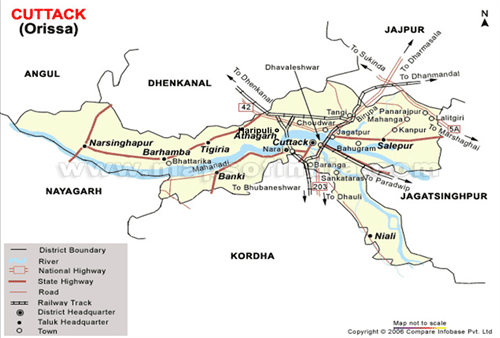
Fig-1a:Map shows the rock shelter sites on the Upper Gondwana Sandstone of Athgarh Formation in and around the delta head of the Lower Mahanadi Valley
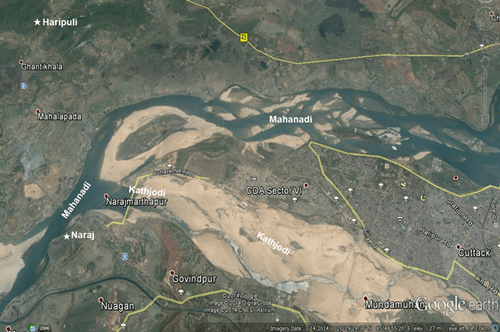
Fig-1b: Satellite Image of the Lower Mahanadi Valley shows the locationof the Rock Shelter sites with rock art evidences
Protracted field exploration has resulted in the discoveries of a good number of lithic artefacts belonging to the different cultures, and five rock shelters sites distinctly located in five different localities around the delta head of the Mahanadi (Sahoo and Naik, 2013: 56-80; Sahoo, 2015a&2015b). Of these five rock shelter sites, in two sites, which are on the verge of destruction, rock art-almost in forms of curious petroglyphs have been discovered and documented. . While one such rock art site is located on the face of a huge rock panel exposed at the foothills of the Siddheswar Mundia close to the village Naraj on the southeast of the Mahanadi, the other is located in a natural cave formed on the waist of the Haripuli hills in the Subasi Reserve Forest area on the north of the Mahanadi. This paper deals with the content and context of these two rock art sites on the basis of the findings of the survey conducted in these sites.
2. The Rock Shelters with Rock Art
2.1 Naraj (NRJ): 20°27’55”N. Latitude; 85°45’45”E. Longitude
Naraj is a place of great antiquity located on the right bank of the river Mahanadi near the bifurcation of Katjuri (Kathjodi) and the Mahanadi in Cuttack Sadar P.S of Cuttack. There is a hill called Siddheswar Mundia just on the right bank of the river Mahanadi. It extends from southwest to northeast direction on the southeast of the river Mahanadi with a high peak on the southwest with a low-lying narrow ridge extending up to the village area of Naraj - Marthapur on the northeast. The hill is found distributed with lateritic formations associated with sandstone knobs and outliers at places at its higher level up to the top. It is also distributed with tough sandstones of Upper Gondwana formation of Athgarh Basin. Such formation is exposed primarily around the low-lying slopes and cliffs formed in northeast, southwest, and northwest of the hill. The landscape, all around hill is sparsely covered by jungle comprising bamboo and indigenous plants of various scrubs, shrubs and vines as well as thorny bushes of edible nuts and berries. While the villages like Naraj and Marthapur are located in close proximity to the north-east of the Siddheswar Mundia, the village Talagarh is located on its southwestern foothills. The South Eastern Railway (East Coast Section) from Barang to Raj Athagarh crosses the river Mahanadi through Naraj-Marthapur Railway Station on the south eastern flank of the Sidheswar Mundia. Naraj is archaeologically famous for the cave temple of Lord Siddheswara - a saivite shrine atop hill of the Siddheswar Mundia which has derived it name from the name of the shrine on it. Geologically, it is also famous for its valuable tough sandstones of Upper Gondwana formation and for precious mineral that is fireclay. As local legend circulates, a huge rock panel engraved with “Sadhe-tini-akshara” (three and half letters), exposed at ground level below a natural cliff on the northwestern flank of the hill, is mysterious. The local people believe that, in the remote past, close to this rock panel, seven gold loaded boats were drowned in the river Mahanadi.. and one who can read the three and half letters can be fortunate to recover this submerged wealth in the river. Recently, a math- a kind of religious institution, has been established near the said rock panel, and the place has acquired the name “Sadhe-tini-akshara” . Some typical rim sherds of a vessel on red ware with red wash treatment were yielded during the survey in this area.
2.1.1 Description of the rock shelter and interpretation of the rock art
The intensive survey on the northwestern flank of the Siddheswar Mundia around Naraj resulted in the discovery of a few archaic rock shelters facing the river Mahanadi. The rock shelters are on the verge of destruction due to prolonged quarrying of sandstones and fireclay from the exposed rifts. There is a huge rock panel of sandstone measuring in length 4.95m and in breadth 2.30m exposed below the archaic rock shelters at about 600m southeast of the Mahanadi (Fig.-2a&2b).

Fig.-2a:Author showing the rock art on the rock panel below the rock shelters facing the river Mahanadi
The exposed rock panel could be a rock shelter having an overhang forming its roof, which was lost facing the same fate as all other rock shelters in the area.
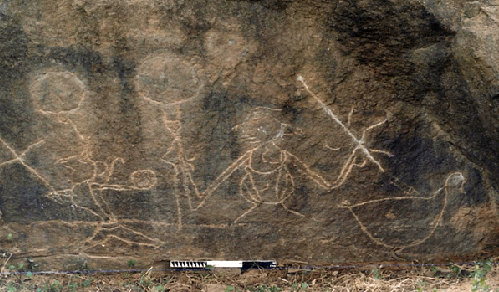
Fig.-2b: Close up view of the engravigs/petroglyphs on the east facing rock panel at Naraj
The rock shelter in the site preserves a number of engravings without any pigmentation, which reveal a kind of human nexus with the rock shelter. The rock art site in this place is identified as “Sadhe-tini-akshara” (three and half letters) and some do call the site as “Adhei-Akshara” (two and half letters) due to some peculiar engravings executed on the back wall of the dilapidated rock shelter. But there is no trace of any letter – the akshara or inscription. Recent survey around the site of “Sadhe-tini-akshara”, during December 2014- January 2015, documented the willful vandalism to the rock shelter site in particular, and also documented the remnants of the archaic rock shelters around the site. The rock shelter with rock art evidence has recently been decorated with irregular lines and floral designs with white pigmentation of lime (Fig.-3a).
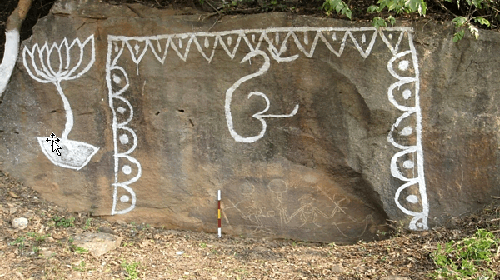
Fig.-3a: Shows the willful vandalism to the rock art site by lime pigmentation
One of the remnants of rock shelter found to the left of the “Sadhe-tini-akshara” rock shelter is in a highly damaged condition because of quarrying of sandstone slabs and nodules by drilling (Fig.-3b).
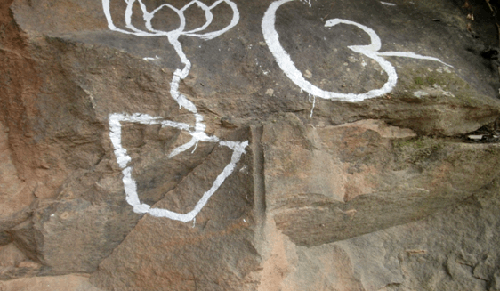
Fig.-3b: Shows heavy drilling for quarrying of sandstone slabs and nodules from the rock shelter
Repeated carving is also marked over the engravings of the “Sadhe-tini-akshara” rock shelter. During the exploration around the rock shelters, the author has discovered and documented seven numbers of peculiar petroglyphs (engravings) of naturalistic and thematic motifs on the above said huge sandstone rock panel. The petroglyphs found in the rock panel are chiefly anthropomorphic and zoomorphic motifs devoid of any pigmentation. The zoomorphic motifs in the petroglyphs include a fish, a bird, a mollusk with dextral coiling and, an enigmatic engraving that looks like a spider. The anthropomorphic motif contains two atypical anthropomorphic figures performing certain activities. The geometric motif in the rock art includes horizontally engraved two separate parallel lines. However, the arrangement of the petroglyphs in the rock panel is from right to left, and more or less in one level at the base of the shelter(Fig.-4a).

Fig.4a: Shows the arrangement of the petroglyphs from right to left
If someone identifies the arrangement of the petroglyphs from west to east, the first figure is of a fish motif engraved with finer lines compared to all other motifs. The second figure on the left of the fish motif is of a short necked water fowl, facing west in a meditative mood probably for a prey. The prey is the fish motif, which is engraved below at the beak of the water fowl (Fig.-4b).
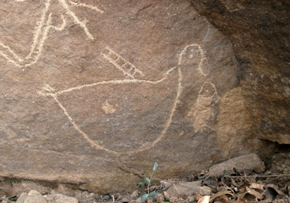
Fig. 4b: Shows the motif of a short necked water fowl and a fish
The third figure on the left of the water fowl is of an anthropomorphic figure characterized by a short neck, two long hands with upward bending from the elbow (drawn in parallel lines); stocky body and inappropriate legs. It holds a stick associated with more or less curved five lines (probably fish hooks) in its left hand, while its right hand holds a a circular-net (Mundalijala) fitted with a long handle. The head of the figure is not prominent but certainly possessed an elongated quiff at its posterior. Irregular marks of abrasion and a prominent curved line on the head from front to back suggest a headgear or a mask. The legs are not properly drawn like hands. The legs are shown as two curved lines with apparent emphasis on the depiction of thigh crossed by a curved line which indicates the pelvic part of the figure. The fourth figure is also of an anthropomorphic figure - smaller and narrower than the third one. The head of this figure is peculiarly designed with two to three short and upward lines, which form a triangular shape on it and also possessed a round quiff - a bun. Behind the head there is an oblique line turned left up to the back, which is ambiguous. The two hands are executed in double lines more or less parallel to its shoulder. The right hand is curved downward from its elbow welded with a straight line. The straight line fitted to the right hand also welded with two lines on its left and right sides, appeared as a cross bar. Thus the fourth figure is holding a stick fitted with a cross bar in the right hand. The stick with cross bar in right hand is apparently a stick-net (Kathijala). The left hand is straight and joined with a circle with bruising marks inside, which indicates the figure has possessed some kind of fodder for the purpose of fishing. The chest portion of the figure is wide and heavy with a narrow waist. The legs are bifurcated from its pelvic point. Its posture as such indicates that it is in a fishing action in a stream or some or other forms of water bodies. The fifth figure is a circular-net (Mundalijala) like engraving in a declined manner behind the fourth figure. Apart from these five engravings, another two separate enigmatic engravings are also documented at about 1.20m to 1.60m away to the left of the fourth figure in the same level of this rock shelter. Thus the sixth figure could be the engraving of a mollusk with dextral coiling (Fig.-4c) and the seventh figure is an enigmatic engraving seems to be the motif of a spider(Fig.-4d).
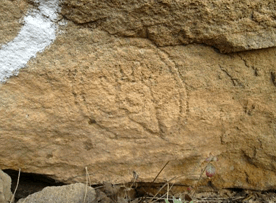
Fig.-4c:Shows the engraving of a mollusk with dextral coiling
Fig.-4d:Shows an enigmatic engraving seems to be the motif of a spider
executed with some indistinct lines and a circle enclosed by a series of curved lines. Keen observation of the engravings in this spot has identified that the motifs of the fish, short necked water fowl and the fourth anthropomorphic figure are prominently executed in between the two parallel lines. It may be interpreted that the third figure (anthropomorphic figure with long hands carrying fishing equipment and the collection bag hanged from shoulder to thigh line) is standing above the upper line while the fourth one (anthropomorphic figure having heavy trunk with bifurcated legs in a fishing position) standing in between the upper and lower lines may suggest fishing activity in a water body like river or stream. Thus, interpretations of petroglyphs (engravings) of Sadhe-Tini-Akshara at Naraj suggest a scene of the fishing activities in the hands of the early settlers of the area. Ethnographic queries on fishing activities of the people in general and fishing community in particular, living around the study area, reveal the contemporary use of Kathijala and Mundalijala among them. Eye observation of the grooved lines of rock art through magnifying glass suggest that the petroglyphs were engraved by means of quite a some kind of hard metal instruments most probably made either of copper or iron.
2.2: Haripuli (HPL):20 ° 32'05"N.Latitude, 85 ° 44'15"E.Longitude.
The Haripuli hill is located near Radhashyampur village in the district of Cuttack. Standing adjacent to the west of the Subasi hill, the Haripuli hill forms the western part of the Subasi Reserve Forest(Fig.-5a).

Fig.-5a: Partial view of the Haripuli hill from the site of Bhagi Dehuri Khola and Belasahi Sahara Sahi
It is a block hill of 169m in height. It is covered with several indigenous plants such as trees, shrubs, scrubs and vines. Various plants of edible nuts and berries are also found in its different nook and corners. At places, it is found distributed with rifts, huge boulders, cobbles and angular nodules of sandstones and pebbles of quartz, quartzite and sandstone. It is about 8 km to the northwest of the river Mahanadi from the Siddheswar Mundia at Naraj, and almost 1 km to the north of Belasahi Sahar Sahi- a hamlet of the Savara tribe. Natural water bodies are found all around the landscape in close proximity of the hill. Barajor on the southwest and Sankhajor on the south are the major perennial streams close to the hill.
The surface reconnaissance around the eastern flank of the Haripuli hill led to the discovery and documentation of the complex of the natural rock shelters along with a peculiar rock art in the form of a petroglyph at one of the shelters on the south. The rock shelter complex with rock art site is located at about 70m to 80m contour elevation on the eastern flank of the Haripuli hill. Though difficult, rugged and narrow, there is an approachable foot track from Radhashyampur to the rock shelter site on the eastern slope of the hill. One can reach the site of the rock shelter through this foot track The open space around the hill slope in front of the rock art site was found to be littered with a number of prehistoric stone tools and river pebbles of quartz, quartzite materials (Fig.-5b).
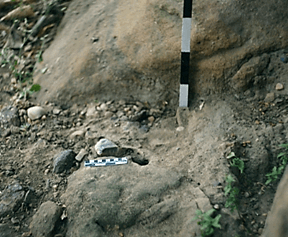
Fig.-5b: Show the distribution of pebbles of various shapes and a Lower Palaeolithic scarper on quartzite in front of the rock art site of Haripuli.
However, the surface survey around the site has led to the finding of eight lithic antiquities- seven belonging to the artifacts of the Lower Palaeolithic period and the rest one is of the Neolithic period(Fig.-5c).
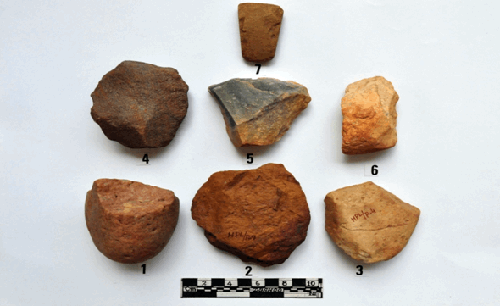
Fig.-5c: The Lower Palaeolithic and Neolithic artifacts collected from the hill slope in front of the Haripuli rock shelter complex
The Lower Palaeolithic artifacts in the collection include one chopper, one hand axe, three scrapers, and two worked pebbles made of quartzite and sandstone raw materials. The rest one is of the Neolithic period characterized by a complete and fully ground and polished Celt on dolerite and weathered to brown in colour. This was found at a place about 60 m contour height on the narrow and rugged foot track leading to the cave site(Fig.-6a).
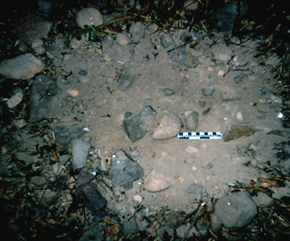
Fig.-6a: In situ evidence of one Neolithic Celt-a small axe at aplace on the foot track to the rock shelter complex of Haripuli hill
The surface survey in the area- around the Haripuli hill has also reported a number of prehistoric sites namely, Bhagi Dehuri Khola, Belasahi-Sahar-Sahi, Cherua, Ghantikhala, Nuasahi Khali Padia, Ramshyampur, Rampei ,Sapei, Subarnamanjaripur, etc.( Sahoo and Naik 2013:56-80; Sahoo2015: The Tribal Tribune, Vol-7, Issue-2) which are situated within 500m-2.0km radius around thehill. These sites were reportedly found associated with the artifacts assemblages belonging to the Palaeolithic, Mesolithic, and Neolithic periods. Author has collected a good number of Lower Paleolithic, Mesolithic and Neolithic artifacts from these sites earlier reported (Fig.-6b&6c).
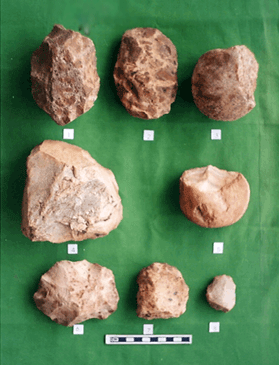
Fig.-6b: The Lower Palaeolithic artifacts collected form the prehistoric sites around the Haripuli hill.
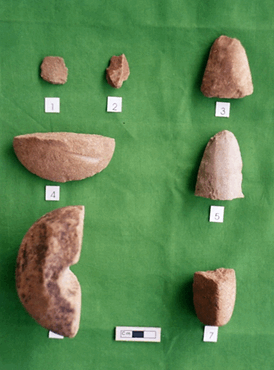
Fig.-6c: The Neolithic artifacts from the prehistoric sites around the Haripuli hill.
Besides, on the south of the Haripuli, the northern crest of the Chepetihuri or Chepeti Mundia: (20°31'30"N.Latitude, 85°43'55"E.Longitude) in the study area has yielded the evidences of an east facing rock shelter - a natural cave at its last legs on the exposed sandstone rifts, a microlithic industry site belonging to Mesolithic period, a fragment of the Neolithic tool and an early shrine at the site of Bhagi Dehuri Khola (Sahoo and Naik 2013:65; Sahoo 2015)
2.2.1 Description of the rock shelter and interpretation of the rock art
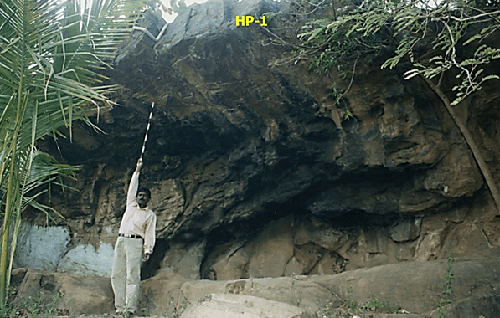
Fig.-7a: One of the rock art shelter (HP-1) in the rock shelter complex

Fig.-7b: Documenting the petroglyph at HP-1 on the extreme south of the rock shelter complex of the Haripuli hill
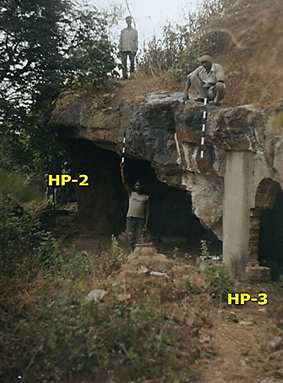
Fig.-7c: Location of the natural rock shelters like HP-2 and HP-3 to the north of the rock shelter HP-1; HP-3 shows the cement construction at its orifice
From the geological point of view, the rock shelter complex (Fig.-7a, b, &c) at Haripuli is certainly a natural cavern with four compartments in one alignment on the sandstone formations of Athagarh Gondwana Basin. The length of the cavity is 34 meters. In height it decreases from south to north. It is 3 meters at its south, 2.80 meters at its mid part and 1.50 meters at the north. During the surface reconnaissance the caves are named as H.P-1, H.P-2, H.P-3, and H.P-4 running from south to north. The cave H.P-1 located in extreme south has its back wall and the ceiling as highly uneven and marked with cracks and falls. But its floor is even and intact with slightly polished mark at places. The cave H.P-2 is more spacious than the H.P.-1, but shorter in height. Its floor has a thick deposit of coarse sand possibly because of long weathering of the wall and roof falls. A thick wall of sandstone and huge termite hill stand between the caves H.P-1 and H.P-2. The H.P-3 is a dome shaped cave having a broad orifice and comparatively short and narrow curved inward passage. The inner space of the cave is very dark. The floor of the same has a deposit of soil and littered with some sandstone pebbles and cobbles of various shapes and sizes. It is reshaped latter by a pillar and wall like cement constructions on its front attached to the original wall, which acts as a separator between the H.P.-2 and H.P.-3 cavities. The H.P-4 adjacent to the H.P-3 is longer than others but shorter in height, and the floor is rocky but intact.

Fig.8a: The natural rock shelter HP-4 at extreme north is longer but shorter than other shelters of Haripuli
As mentioned earlier the cave H.P-1 preserves a peculiar rock art executed in form engravings of prehistoric nature. It is situated inside the extreme southern wall and close to the floor of the cave H.P-1. The engraving appears to be of a naturalistic and thematic representation with an anthropomorphic and more than two zoomorphic figures. It seems to be an animal with its kid taking rest beneath a tree or involved in grazing in the forest, and a man is about to catch the younger ones.
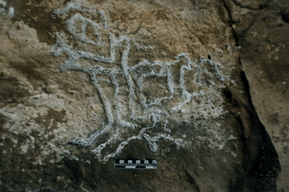
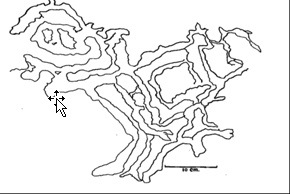
Fig.- 8b:Photograph of the petroglyph at HP-1 on the extreme south of the rock shelter complex of the Haripuli hill
Fig.- 8c: Trace-sketch of the petroglyph at HP-1 on the extreme south of the rock shelter complex of the Haripuli hill
It was made by scooping out of material substances of the sandstone canvas to leave deep visible marks. The lines of the engravings possibly were executed by continuous pecking, scratching and constant rubbing techniques with certain kinds of pointed and sharp implements made of hard rock or bone. The engraved lines of the engraving chiefly possess ‘V’ or ‘U’ pattern cross-section and are without pigmentation. The maximum breadth and depth of the engraved lines of this rock art measures 0.5-3.0cm and 1.0-2.5cm respectively. The engraved lines are mostly irregular in forms, which indicate the rock art is either artistically less developed or weathered due to alternate hydration and dehydration, and oxidation of bonding materials of the rock canvas. The rock art in the rock shelter at Haripuli belongs to the Neolithic period and anyone of the pastoral herdsmen might have engraved these thematic petroglyphs at this place.
3. Threats to rock shelter and rock art
As far as the state of preservation is concerned the rock shelters discovered and documented on sandstone hills of Athgarh Gondwana Basin around the delta head are mostly on the verge of destruction and some arealready destroyed. Obviously environmental factors like rise of mercury in hot summer, copious rains, thunders and storms, aridity and humidity in climate are the potential threats to the rock shelters, and the rock art within. The anthropogenic impacts on such cultural heritage of mankind is also responsible for its destruction.. From intensive survey of the aforesaid area, it has been observed that the environmental factors such as hot summer causing dehydration and rains causing hydration have subjected the rock sheltersto alternate hydration and dehydration, which leads to the accumulation of smoke and dust, as well as oxidation of bonding material of the exposed rock surfaces in the rock shelters at Haripuli and Naraj. In fact the engraved lines in some of the motifs in the rock art complex of Naraj have become murky and are invisible due to accumulation of smoke and dust. Marks of roof falls and even mass falls from the ceilings, walls and facets are also found at the rock shelters of Haripuli chiefly because of cracks due to summer heat. Roof falls are also due to growth of some thick rooted plants in the cracks in the roof. Anthropogenic factors such as making fireplaces inside the cave during forest feast, setting fire in dry leaves and twigs littered around the cave site have caused damage to the Haripuli rock shelters. Intense quarrying of sandstone slabs by drilling and by using dynamite are also noticed at the rock art site of Naraj. The rock shelters with rock art are also facing the same fate in other parts of the country. In this regard, the State Archaeology Departments, Archeological Survey of India, Indian National Trust for Art and Cultural Heritage, National Research Laboratory for Conservation should take up the responsibility for timely conservation of the rock art and the rock shelters of this country before they are damaged beyond repair..
4. Conclusion
Archaeological investigations of the author in and around the delta head of the Mahanadi reveal that there are two natural rock shelters having the evidences of typical rock art in the form of petroglyphs. The ancient rock shelters are naturally formed on the sandstone hills of Upper Gondwana formation in Athagarh Basin (Tiwari et al., 1987) in the district of Cuttack. As mentioned earlier out of these two; one is located on the Mahanadi at Siddheswar Mundia near Naraj; whereas the second one is located on the Haripuli hill at about eight kilometres away towards the north of the Siddheswar Mundia on the Mahanadi. The shelters are situated in different altitudes. Though both of the rock art sites have some enigmatic engravings , the presence of some zoomorphic and anthropomorphic figures reveal the early artistry in the rock shelters, which express the subsistence strategies of the early habitants in the study area. The petroglyphs on the rock panel at Siddheswar Mundia were engraved probably by means of a kind of hard metal instrument most probably made either of copper or iron. Based on the styles of execution and the pottery remains obtained from the surroundings of the shelter, a relative date to the engravings may be assigned that could be between the proto-historic metal age and early historic period..
However, it can be inferred that the rock art in the rock shelter at Haripuli belongs to the Neolithic period and anyone of the pastoral herdsman could have engraved this thematic petroglyphs at this place. This presumption is strengthened by the recovery of a Neolithic tool close to the site and the sites which yielded the same cultural relic in close proximity around the hill. So far the early habitation of the cave is concerned the availability of the lower Palaeolithic artifacts at the rock shelter is the best evidence to substantiate the fact that the Palaeolithic people had occupied the area at a suitable time of the lower Pleistocene to the middle Pleistocene. Thus the cave at the site might have occupied firstly by the Palaeolithic denizens and later by the Neolithic people in the Holocene. Geoarchaeological points of view, in and around the delta head on the Lower Mahanadi Valley the rock art sites at the natural rock shelters formed in the medium to coarse grained sandstones of the Upper Gondwana formation of Athgarh Basin could have been occupied by the mankind from the prehistoric Palaeolithic to the early historic through the Neolithic - protohistoric metal age periods. The hypothesis about the human occupation and cultural chronology is purely based on the spatial data whatever gathered from the intensive exploration the rock art sites. Essentially the rock shelter sites with rock art require further study, planning to systematic excavations at the floor deposits of the same. In fact excavations of the floor deposits may throw new light on the antiquity and chronology of the site.
References
-
Behera, P. K. (1991-1992). Prehistoric Rock Art Paintings to fertility Cult and Other Subjects of Orissa.Pragdhara, 2,7-17.
-
Behera, P.K.(2001). Investigation into the Newly Discovered Rock Art Sites of Deulga hills, Orissa. Pragdhra, 11, 3-11.
-
Blinkhorn, J, Boivin, N. , Tacon, Paul S.C. , and Petraglia, Michale D. (2012). Rock Art Research in India: Historical Approaches and Recent Theoretical Directions. In Jo McDonald and Peter Veth. (ed). A Companion to Rock Art, pp. 179-196, Blackwell Publishing Ltd.
-
Chakravarti, N.P. (1936). The Vikramkhol Rock Inscription. Annual Report of Archaeological Survey of India, 1930-34, I: 229.
-
Chakravarty, K. K., and Bednarik, R. G. (1997). Indian Rock Art and its Global Context. New Delhi: Motilal Banarsidass Publishers Pvt.Ltd.
-
Chakraverty, S. (2003). Rock Art Studies in India: A Historical Perspective. Kolkata: Asiatic society.
-
Cockburn, J.(1883). A Short Account of the Petrographs in the Caves and Rock Shelters of the Kaimur Range in Mirzapore District. Proceedings of the Asiatic Society of Bengal, 52, 125-26.
-
Fawcett, F. (1892). Prehistoric Rock pictures near Bellary. Asiatic Quarterly Review (n.s.) 3,247-57.
-
Ghosh, M. (1932). Rock Paintings and Other Antiquities of Prehistoric and Later Times. Memoirs No. 24. Calcutta: Archaeological Survey of India.
-
Fabri, C.L. (1936). The Vikaramkhol Rock Inscription, Editorial remark. Annual Report of Archaeological Survey of India, 1930-34, I: 230.
-
Jayswal, K.P. (1933). The Vikramkhol Inscriptions, Sambalpur District. The Indian Antiquary, Vol. LXII, 58-60.
-
Indian Archaeology, 1969-70. A Review, pp. 30; Orissa (43). Exploration in Districts of Sambalpur and Sundargarh.
-
Indian Archaeology, 1969-70. A Review, pp. 61 (15) Prehistoric Rock-Shelter, Hemagiri, District Sundergarh.
-
Mahabaleswara, T.D. (2014). The world of rock art. Current Science, 106(5.), 654-5
-
Mathpal, Y. (1995). Rock Art in Kumaon Himalaya. New Delhi: Indira Gandhi National Centre for the Arts & Aryan Books International.
-
Mathpal, Y. (1998). Rock Art in Kerala. New Delhi: Indira Gandhi National Centre for the Arts & Aryan Books International.
-
Mishra, B., Pandya, K. L. , and Maejima, W. ( 2004). Alluvial Fan - Lacustrine Sedimentation and its Tectonic Implications in the Cretaceous Athgarh Gondwana Basin, Orissa, India. Gondwana Research, 7(2),375-385.
-
Mohapatra, G.C. (1982). Notes on the Vikramkhol and Ushakothi Rock Shelters in Orissa, Man and Environment, VI, 97-100.
-
Neumayer, E. (1992). Rock pictures in Orissa. Puratattyva, 22, 13-24.
-
Neumayer E. 1993. Lines on Stone, the Prehistoric Rock Art of India, Manohar Publisher and Distributors, New Delhi.
-
Pradhan, S. (1995-96). Rock Engraving in the Rock Shelters of Upland Orissa, Puratattva, 26,32- 42.
-
Pradhan, S. 1997. Prehistoric Art. In P.K. Mishra & J.K. Samal (ed). Comprehensive History and Culture of Orissa. pp. 46-53, New Delhi: Kaveri Books.
-
Pradhan, S. (2000). Rock Art of Orissa. In K.K. Basa&P.Mohanty (ed). Archaeology of Orissa, Vol.II,635-650, Delhi: PratibhaPrakashan.
-
Pradhan, S. (2001). Rock Art in Orissa, Aryan Books International, New Delhi.
-
Sahoo, D. and Naik, S. K. (2013). Stone Age Cultures around Ghantikhal Area, Cuttack District Coastal Odisha. Man in Society, 20,56-80. The Journal of Anthropology Department, Utkal University, Bhubaneswar.
-
Sahoo, D. 2015a. Palaeolithic Sites in the Lower Mahanadi Valley. The Tribal Tribune Vol.-7, Issue-2(ISSN:2249-3433), http://www.etribaltribune.com
-
Sahoo, D. 2015b. Prehistoric Rock Shelter Sites around the Delta Head on the Lower Mahanadi Valley, Odisha, The Tribal Tribune Vol.-7, Issue-3, 2015 (ISSN: 2249-3433), http://www.etribaltribune.com
-
Tiwari, R.S., Tripathi, A., Dutta, A.B., and Mukhapadhyay, A. , (1987). Palinological Dating of Olive-Green Shales underlying the Athagarh Sandstone in Mahanadi Basin. Current Science,56 (2), 1150-1153.
Acknowledgements
The author conveys special thanks to ShriSubrat K. Naik, a Ph.D. Scholar in Anthropology (R.G.N.Fellow), ShriTarunkantiMohapatra, photographer-cum-artist, Department of Anthropology, Utkal University, Bhubaneswar and ShriSadanandaDehury, a resident of the village Belasahi SaharaSahi for their immense assistance during the field survey in the study area.
Senior Lecturer in Prehistoric Archaeology, P.G. Department of Anthropology (U. G. C. Centre of Advanced Studies),Utkal University, Bhubaneswar -751 004. Email: This email address is being protected from spambots. You need JavaScript enabled to view it.

